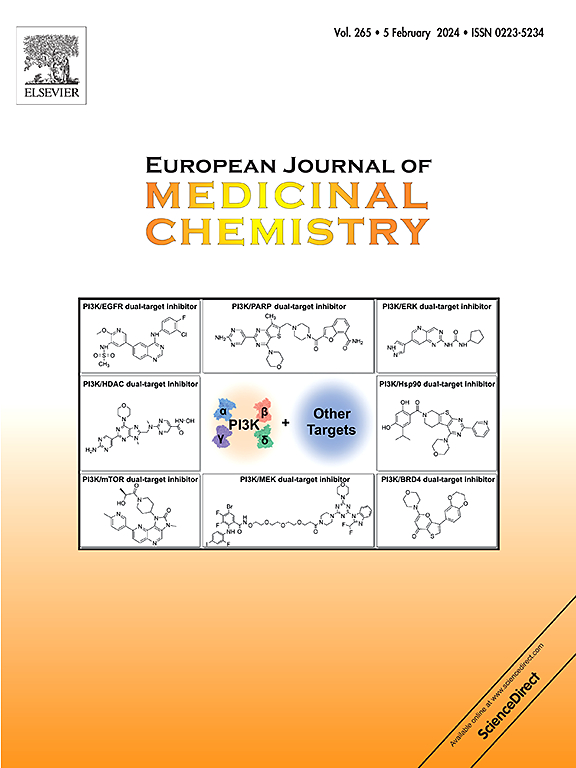高效的Ru(II)和Os(II)半夹心复合物通过线粒体和内质网联合应激诱导癌细胞的细胞毒性
IF 6
2区 医学
Q1 CHEMISTRY, MEDICINAL
引用次数: 0
摘要
合成了一系列钌(II)和锇(II)半夹心配合物,并对其作为一类新型抗癌药物的潜力进行了表征。该配合物以多环芳烃(PAH)取代的希夫碱基为特征,经过合理设计,结合了半夹心Ru、Rh、Os和Ir配合物的氧化还原调节MoA,与它们诱导各种ROS形成的能力有关,以及PAH取代基靶向和破坏DNA的能力。配合物[Ru(η - 6-pcym)Cl(L)]PF6(1-4)和[Os(η - 6-pcym)Cl(L)]PF6(5-8)在水环境中稳定,而共同研究的铑(III)(9-12)和铱(III) (13-16) [M(η - 5- cp *)Cl(L)]PF6配合物在水环境中降解迅速;L =乙烷-1,2-二胺基希夫碱(L1 - L4),具有两个末端多环芳烃取代基- 2-萘基(L1), 9-蒽基(L2), 9-菲蒽基(L3)或1-芘基(L4);pcym = 1-甲基-4-(丙烷-2-基)苯(对伞花烯),Cp* =五甲基环戊二烯。生物学试验表明,1-8对多种肺癌细胞系具有显著的抗增殖活性,包括对顺铂耐药的肺癌细胞系,其中Os(II)复合物5显示出最高的细胞毒性。这些复合物导致应激相关基因通路的激活,包括非常规内质网应激、凋亡信号传导和线粒体膜去极化。p21/GADD45A通路的激活也表明dna损伤反应。值得注意的是,这些复合物不会引起明显的炎症反应,这是与顺铂相比的一个显著优势。结果突出了钌和氧化锇半夹层配合物作为替代金属药物的潜力,能够克服铂耐药性并最小化炎症副作用。本研究表明,这些化合物有望成为未来临床开发的一类有前景的抗癌药物。本文章由计算机程序翻译,如有差异,请以英文原文为准。


Highly effective Ru(II) and Os(II) half-sandwich complexes induce cytotoxicity in cancer cells through combined mitochondrial and endoplasmic reticulum stress
A series of ruthenium(II) and osmium(II) half-sandwich complexes was synthesized and characterized for its potential as a new class of anticancer agents. The complexes feature polycyclic aromatic hydrocarbon (PAH)-substituted Schiff bases and were rationally designed to combine the redox-modulating MoA of half-sandwich Ru, Rh, Os and Ir complexes, connected with their ability to induce the formation of various reactive oxygen species (ROS), with the ability of PAH-substituents to target and disrupt DNA. The complexes [Ru(η6-pcym)Cl(L)]PF6 (1–4) and [Os(η6-pcym)Cl(L)]PF6 (5–8) were stable in aqueous environments, in contrast to the rapid degradation observed for the co-studied rhodium(III) (9–12) and iridium(III) (13–16) [M(η5-Cp∗)Cl(L)]PF6 complexes; L = ethane-1,2-diamine-based Schiff bases (L1–L4) bearing two terminal PAH substituents 2-naphtyl (for L1), 9-anthracenyl (for L2), 9-phenanthrenyl (L3) or 1-pyrenyl (L4); pcym = 1-methyl-4-(propan-2-yl)benzene (p-cymene), Cp∗ = pentamethylcyclopentadienyl. Biological testing demonstrated that 1–8 possess significant antiproliferative activity against various lung cancer cell lines, including those resistant to cisplatin, with Os(II) complex 5 showing the highest cytotoxicity. Treatment with these complexes led to the activation of stress-related gene pathways, including unconventional endoplasmic reticulum stress, apoptotic signalling, and mitochondrial membrane depolarization. Activation of p21/GADD45A pathway indicates DNA-damage response, as well. Notably, these complexes did not induce significant inflammatory responses, a notable advantage over cisplatin. The results highlight the potential of Ru and Os half-sandwich complexes as alternative metallodrugs, capable of overcoming platinum resistance and minimizing inflammatory side effects. This study suggests that these compounds could serve as a promising class of anticancer agents for future clinical development.
求助全文
通过发布文献求助,成功后即可免费获取论文全文。
去求助
来源期刊
CiteScore
11.70
自引率
9.00%
发文量
863
审稿时长
29 days
期刊介绍:
The European Journal of Medicinal Chemistry is a global journal that publishes studies on all aspects of medicinal chemistry. It provides a medium for publication of original papers and also welcomes critical review papers.
A typical paper would report on the organic synthesis, characterization and pharmacological evaluation of compounds. Other topics of interest are drug design, QSAR, molecular modeling, drug-receptor interactions, molecular aspects of drug metabolism, prodrug synthesis and drug targeting. The journal expects manuscripts to present the rational for a study, provide insight into the design of compounds or understanding of mechanism, or clarify the targets.

 求助内容:
求助内容: 应助结果提醒方式:
应助结果提醒方式:


